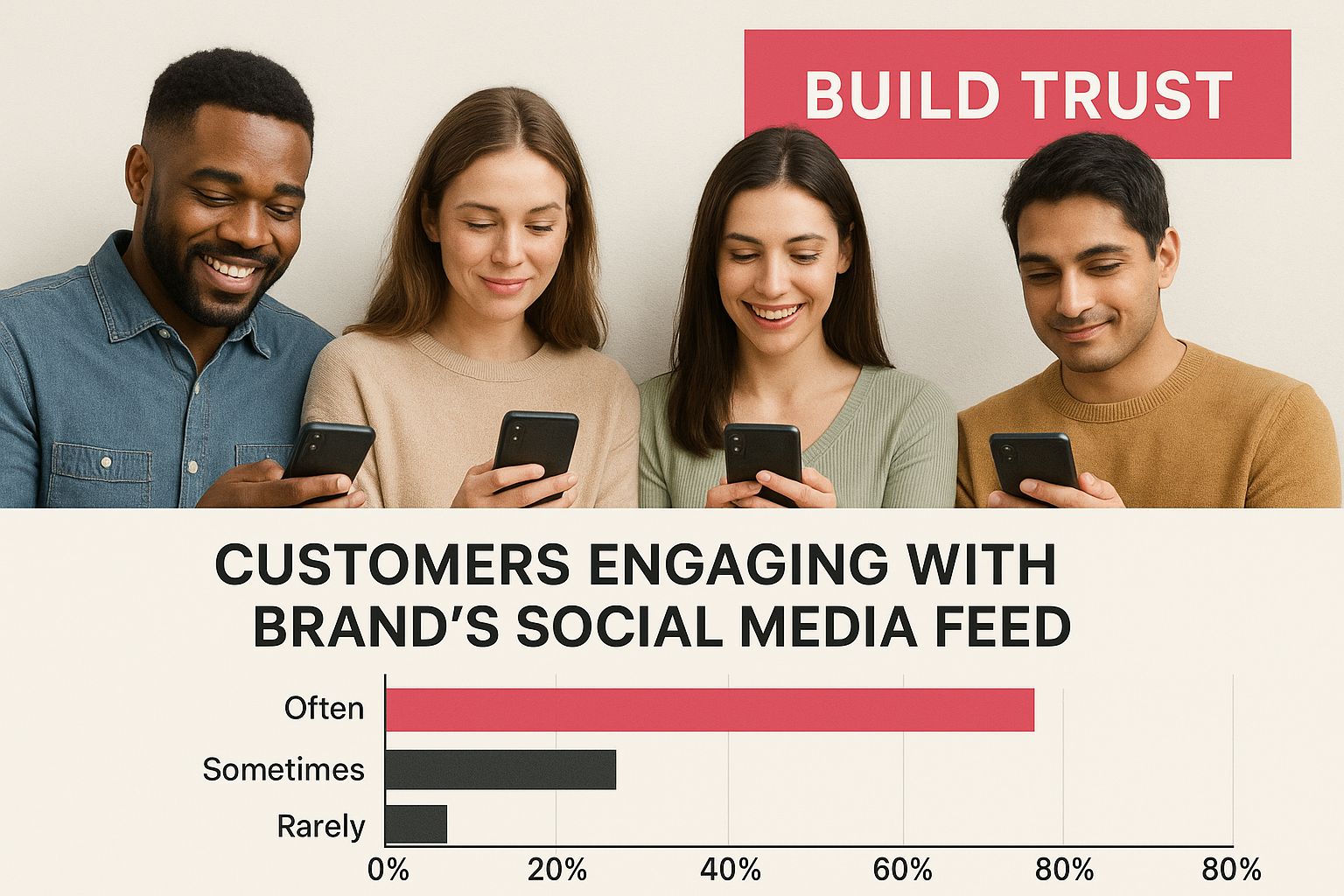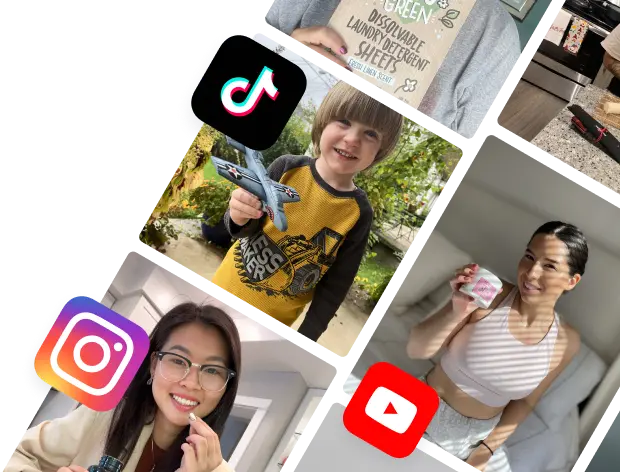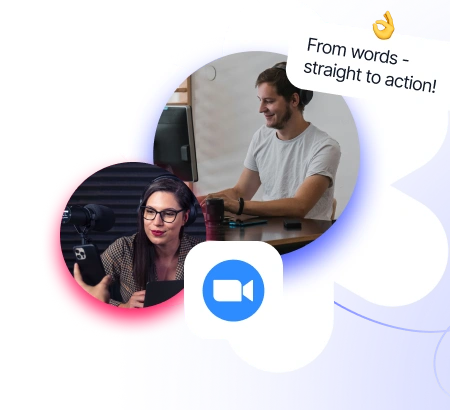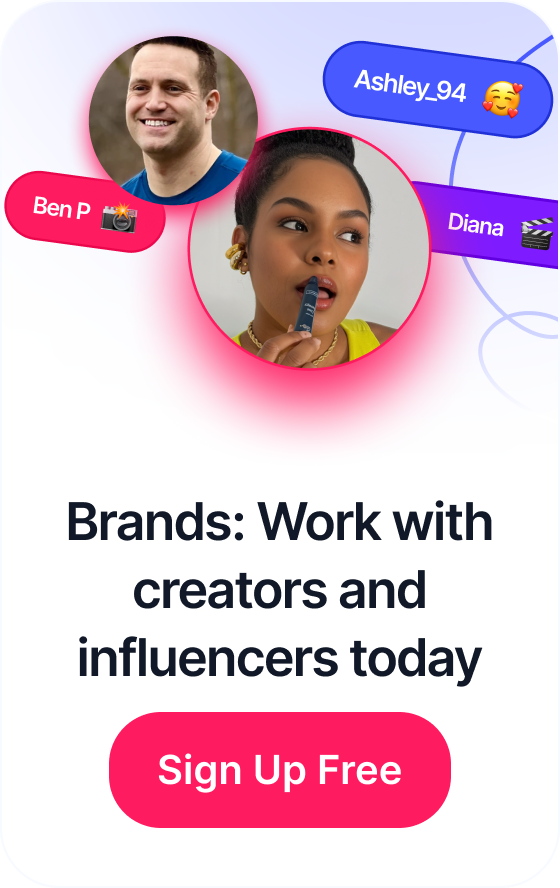 Smart Digital Marketing Budget Allocation
Smart Digital Marketing Budget Allocation
Table of Contents
Why Your Customers' Content Outperforms Your Marketing Team
Let's be honest: your customers are rockstar salespeople, often without even realizing it. I've chatted with so many brand managers who've poured their hearts into meticulously planned campaigns, only to see them eclipsed by a simple customer video. Why? Authenticity. It's the secret sauce.
Think about it: a polished, big-budget ad screams "marketing," while a shaky iPhone video from a real person feels like a trusted friend giving you the inside scoop. This taps into something deep within us. We're programmed to trust our peers way more than brand messaging. It's just human nature.
For example, picture two videos about a new blender. One is a slick, professional production highlighting all the fancy features. The other? A quick, genuine clip of someone whipping up a smoothie in their own kitchen. Which one feels more real, more relatable? Chances are, it's the second one. It’s not about fancy cameras and editing; it’s the raw, unfiltered enthusiasm that shines through.
That’s the magic of user-generated content (UGC). It shows your product in action, in real life, loved by real people. And this translates directly into sales. We're all swayed by real stories, not perfectly crafted marketing narratives. It's the difference between hearing about a great restaurant and seeing your friend rave about their amazing meal there.
This shift towards authenticity isn't just a feeling; it's backed by hard data. Creating effective UGC is about understanding the strategic advantage it gives your brand. By 2025, brands using UGC are projected to see a 29% increase in web conversions compared to those who don't. That's huge! And a massive 79% of people say UGC directly influences their buying decisions. Even something as simple as buying clothes is impacted, with over 66% of people checking out reviews and comments before hitting "add to cart." Want more UGC stats? Check this out. These numbers tell a powerful story: genuine connection is king in the marketing world.
I've seen brands who were initially hesitant about UGC become total converts after seeing their conversion rates jump. They realize that loosening the reins a bit and embracing the raw, authentic voice of their customers actually amplifies their message. This isn’t about ditching professional marketing altogether; it's about adding the power of real customer experiences to the mix. The smartest brands get this symbiotic relationship. They understand that while they can tell a story, their customers can make it truly believable. This understanding blows apart those misconceptions that hold brands back from fully embracing the potential of UGC and unlocks a world of authentic engagement.
Discovering Your Hidden Content Goldmine
Your best content creators aren't necessarily those with a massive following. They're often your existing customers, already using and loving your products. Finding these passionate fans is like striking gold – a content goldmine waiting to be tapped. It's all about identifying those who genuinely connect with your brand and are creating compelling content organically.
Think of it like this: you're panning for gold. You have to sift through a lot of sand and gravel, but the reward is worth it when you find those gleaming nuggets. Similarly, you might need to do some digging on social media and in online reviews, but you'll uncover those gems of authentic content – pure gold for your brand. This isn’t a last-ditch effort; it’s about smart prospecting.
The most successful brands understand this. They don’t just see creators as a means to an end. They build genuine relationships. It’s about fostering a sense of community and showing appreciation. Imagine getting a message from a brand saying, "We loved your recent post! Your photography is stunning." That's way more impactful than a generic, "We'll pay you to post about us."

This infographic shows how customer engagement with a brand’s social media builds trust and highlights the importance of authentic connections.
The infographic really brings home the idea that building trust leads to more receptive audiences for user-generated content (UGC). It visually highlights the organic link between brand and customer – that’s the key to inspiring authentic content and learning how to create ugc content effectively.
Understanding Creator Motivations
Every creator is different. Some thrive on recognition, while others value exclusive opportunities. Understanding these nuances will help you tailor your approach. For example, a creator who consistently posts beautiful product photos might be motivated by a feature on your brand's Instagram page. A creator who makes in-depth video reviews might appreciate early access to new products.
Cultivating Organic UGC
Creating an environment where UGC flourishes organically is crucial. This means actively engaging with your community—responding to comments and messages, and showcasing existing UGC. Show your appreciation and make creators feel valued. This fosters a sense of belonging and encourages more organic content creation.
It’s a delicate balance: providing some guidance while still preserving the creative freedom that makes UGC so powerful. Empower creators to tell their stories their way. The result? Even more authentic and engaging content.
To help you better understand outreach, let's look at the following table summarizing some key strategies across various platforms:
To effectively connect with creators, understanding the nuances of each platform is crucial. The following table, "Creator Outreach Strategies by Platform," offers insights into best practices and expected response rates.
Creator Outreach Strategies by Platform
Comparison of effective outreach methods across different social media platforms, including response rates and best practices
| Platform | Best Outreach Method | Average Response Rate | Content Type Focus |
|---|---|---|---|
| Direct Message (DM) | 10-15% | High-quality images and short videos | |
| TikTok | Comments and DMs | 5-10% | Short-form videos, trends, and challenges |
| YouTube | Email and comments | 15-20% | Long-form videos, reviews, and tutorials |
| Groups and Messenger | 20-25% | Text posts, images, and live videos |
This table gives you a starting point for planning your outreach. Remember, these are just averages. Response rates can vary depending on your industry, the creator’s audience, and your outreach message. The key takeaway? Tailor your approach to each platform and focus on building authentic connections.
Designing Campaigns That Spark Authentic Creativity
The real magic of user-generated content (UGC) isn't about asking for it; it's about inspiring it. Think of it like this: you're not just collecting content, you're building a relationship with your audience. The difference between a tidal wave of bland content and truly engaging UGC all boils down to how you ignite that authentic creativity. Need some fresh ideas to get the ball rolling? Brainstorm some compelling content creation ideas that will get your audience excited to participate.
Remember the Starbucks White Cup Contest? Pure genius! They simply asked customers to decorate their cups and share photos using #WhiteCupContest. The prize? A simple gift card and the thrill of potentially seeing their design on a reusable cup. It was a brilliant move because it tapped into an existing customer habit (who hasn't doodled on a Starbucks cup?), offered a fun incentive, and generated tons of visually appealing content. The takeaway? Find the natural sweet spot where your product and your audience's creativity intersect.
Crafting the Perfect Brief
Your campaign brief is the creator's roadmap. It needs to provide clear direction without being too restrictive and stifling their individual style. Imagine providing the canvas and a few basic colors, then letting the creator paint their own masterpiece. Instead of micromanaging every little detail, give them a broad theme and some suggested hashtags. This provides enough guidance to keep things on-brand while giving creators the freedom to inject their own personality.
Finding the right balance between branded elements and genuine expression is crucial. Too much branding, and the content feels forced and artificial. Too little, and it loses its connection to your brand. Think of it like seasoning a dish – just enough to enhance the flavor, not overwhelm it.
The Psychology of Effective Prompts
The right prompt can be a powerful tool. Instead of generic calls to action, try something more engaging. Ask questions that invite reflection or encourage personal stories. For example, instead of a bland "Share a photo with our product," try something like, “What’s your favorite memory using our product?” This encourages more thoughtful and authentic responses.
Timing is key, too. Launching your campaign during a relevant event or holiday can significantly boost participation. Think of a swimwear brand launching a UGC campaign during the summer – it just makes sense! Creating a sense of community is also vital. Make your campaign feel like a movement, not just a task. Encourage creators to interact with each other and share their experiences.
Want to dive deeper into UGC strategy? Check out this article on building a comprehensive user-generated content strategy. It covers everything from planning and execution to optimization.
Creating truly amazing UGC hinges on understanding your audience, giving them the right tools, and then stepping back and letting their creativity shine. It's all about building a connection, not just collecting content. When you approach UGC with this mindset, the results can be truly amazing.
Building Systems That Handle Success

This image showcases how user-generated content can be seamlessly integrated into a brand's online presence through a streamlined management system.
So, your UGC campaign is exploding, and the content is flowing in. That's amazing! But now, you've got to build a system that can actually handle all that awesome content. You don't want to create bottlenecks or, even worse, annoy the creators who are generously sharing their work.
Think of it like this: you're building a dam. You need a solid structure to manage that flood of content effectively. This section is your blueprint for creating efficient workflows for reviewing, approving, and organizing your user-generated content (UGC), all while keeping your quality bar high. Even campaigns built to inspire authentic creativity need organization. A social media content calendar can be a real lifesaver here.
Establishing Clear Approval Criteria
Before anything else, you need crystal-clear approval guidelines. This protects your brand while also respecting the unique voices of your creators. It's about setting healthy boundaries, not stifling creativity.
Transparency is paramount. Let creators know your expectations from the get-go. For example, you might specify content that reflects your brand values, steers clear of controversial topics, and meets certain quality standards for lighting and sound. This isn't about censorship; it's about ensuring the content represents your brand in a positive light.
Streamlining the Review Process
Next up: create a smooth review process. Project management tools can be incredibly helpful for organizing submissions, assigning reviewers, and tracking progress. You don't want content disappearing into a void.
Find a balance between efficiency and that essential human touch. A quick turnaround shows creators you value their contributions and keeps them excited to collaborate.
Providing Constructive Feedback
Sometimes content might not quite hit the mark. That’s okay! When that happens, offer constructive feedback. Focus on how creators can improve future submissions, rather than simply rejecting their work. This builds a positive, collaborative relationship and encourages ongoing participation. Remember, every creator, no matter their follower count, has the potential to create something amazing.
Navigating Legal and Usage Rights
And of course, the legal side of things. Clearly define usage rights upfront. Be transparent about how you intend to use the content and for how long. This prevents misunderstandings and protects both you and the creator. It sets the foundation for a professional, mutually beneficial working relationship.
Before we move on, I want to share a handy checklist I use when reviewing UGC. It helps me stay organized and ensures I'm covering all the bases:
UGC Content Review Checklist
Essential criteria for evaluating user-generated content submissions, organized by priority level
| Review Category | Must-Have Elements | Nice-to-Have Elements | Red Flags |
|---|---|---|---|
| Brand Alignment | Reflects brand values, consistent messaging | Subtle brand integration, unique perspective | Contradicts brand message, off-brand humor |
| Legal & Rights | Creator consent for usage, clear rights agreement | Long-term usage rights, exclusivity | Copyright infringement, unclear ownership |
| Content Quality | Good lighting and sound, clear visuals | Professional editing, creative storytelling | Poor quality video/audio, blurry images |
| Platform Relevance | Optimized for platform format, uses relevant hashtags | Incorporates platform trends, engages with comments | Wrong aspect ratio, irrelevant hashtags |
This checklist helps prioritize what's absolutely essential, what adds extra value, and what's a definite no-go. It’s a game-changer for maintaining quality and consistency.
Building these systems might feel like a lot of work upfront. Trust me, it’s worth it. It’s the difference between a thriving, scalable UGC program and a disorganized free-for-all. It allows you to handle the volume, maintain high-quality content, and – most importantly – keep your creators happy, engaged, and creating amazing content for your brand.
Amplifying UGC Across Your Marketing Universe
Creating amazing user-generated content (UGC) is only half the battle. The real impact comes from distributing it effectively. Think of your UGC as a megaphone for your brand's message – you've crafted the message, now you need to share it with the world. This is where so many brands stumble. They develop great content, then leave it to gather dust in some forgotten corner of the internet. Don't make that mistake!
Let’s talk about how successful brands weave UGC into their entire marketing strategy, from social media and email campaigns to product pages and paid advertising. The key is matching the right content to the right platform. A quirky TikTok video might be perfect for Instagram Reels, but it won't resonate on a professional LinkedIn post. Similarly, a glowing customer testimonial shines on a product page, but it gets lost in a Twitter thread.
Repurposing Content While Maintaining Authenticity
Repurposing content maximizes the value of your UGC. A customer's Instagram photo could be featured in your email newsletter, or a series of tweets might become a compelling blog post. But there's a critical element: authenticity. The moment UGC feels overly polished, it loses its genuine appeal. Think of it like this: a live concert recording has energy and excitement. A heavily edited studio version might sound technically perfect, but it lacks that same spark.
Creative Showcasing for Engagement and Sales
Think outside the box when showcasing your UGC. Imagine an interactive gallery on your website where customers can browse UGC by product. Or picture a social media contest where users vote for their favorite customer photos. It's about giving UGC the attention it deserves. I worked with a skincare brand that created a "Customer Spotlight" on their Instagram profile. Every week they featured user photos and stories, highlighting real-life results. Engagement went through the roof! For more on the power of UGC, check out the benefits of user-generated content.
Giving Credit Where Credit Is Due
This one’s important: always credit the creators. Tag them on social media, link back to their original posts, and maybe even offer small incentives like discounts or early access to new products. This demonstrates appreciation and encourages future contributions. It’s a small act that builds a strong creator community.
Measuring the Impact of Distributed Content
Track the success of your UGC. Don't just post it and hope for the best. Monitor metrics like engagement, website traffic, and conversion rates. This data provides valuable insights into what resonates with your audience and what needs adjustment. It's a process of continuous improvement.
It’s also important to acknowledge the growing economic influence of UGC. As of 2025, the UGC market was valued at over $7.6 billion, a significant 69% increase from $4.5 billion in 2024. This growth is driven by tighter marketing budgets and the demand for authentic content. Projections suggest that by 2033, a staggering 78% of online content will be user-generated. This emphasizes the vital role UGC plays in shaping consumer opinions and driving purchasing decisions. For a deeper dive into these numbers, discover more insights on UGC market growth here.
By mastering UGC distribution, you can transform authentic customer stories into a powerful engine for brand growth. Treat your UGC like the valuable asset it is, integrating it seamlessly into your marketing strategy. This creates a cohesive narrative that resonates with your audience and delivers real results.
Tracking What Actually Moves The Needle
Vanity metrics are tempting. High likes and shares look great on reports, but do they actually translate into sales? In my experience, focusing on the right metrics—those tied to revenue growth—is the key to a successful user-generated content (UGC) strategy. It’s not about impressing stakeholders with flashy numbers; it’s about making smart, data-driven decisions. You might find this article about measuring the ROI of your influencer marketing campaigns helpful, as many of the principles apply to UGC measurement as well.
Remember, it’s all about impact, not just impressions.
Identifying Key Performance Indicators (KPIs)
The KPIs you track should directly align with your specific business objectives. If your goal is to boost brand awareness, then focus on reach and engagement. If you’re aiming for higher conversions, track click-through rates and sales directly attributed to your UGC. Choose the metrics that actually matter for your unique goals. Don’t fall into the vanity metric trap!
I've seen firsthand how easily brands can get sidetracked by likes and shares. Focus on what truly impacts your bottom line.
Learning from brands that have successfully scaled their UGC programs is invaluable. Many of these brands prioritize conversion rate, which measures the percentage of visitors who take a desired action (like making a purchase). Another important metric is customer lifetime value, which predicts the total revenue a customer will generate throughout their relationship with your brand. These metrics paint a much more comprehensive picture of your success than simple likes and shares ever could.

This screenshot from Google Analytics shows how you can track website traffic coming from your UGC campaigns.
This kind of data is gold. The screenshot shows how analytics can pinpoint which UGC campaigns are driving traffic to your website. This is crucial for understanding what content resonates with your audience and ultimately leads to conversions. By analyzing your website traffic sources, you can identify high-performing UGC and replicate its success in future campaigns.
Refining Strategies with Data Insights
Data isn’t just for reporting; it's a powerful tool for continuous improvement. Use data insights to refine your creator relationships and campaign strategies. For example, if certain types of UGC consistently outperform others, encourage your creators to develop more of that content. If a particular platform is driving more conversions, allocate more resources to that platform. It’s a constant cycle of learning and optimizing.
Think of data as your secret weapon for optimizing your UGC strategy.
Demonstrating ROI and Continuous Improvement
Stakeholders want to see tangible results. Use your data to clearly demonstrate the ROI of your UGC program. Show how UGC contributes to increased sales, website traffic, and brand awareness. This not only justifies your investment but also builds confidence in your strategy.
Finally, embrace a framework for continuous improvement. Regularly analyze your data, identify areas for improvement, and adjust your strategy accordingly. This ensures your UGC program remains effective and aligned with your evolving business goals. Don't rely on guesswork—let the data be your guide. A data-driven approach ensures your user-generated content (UGC) program delivers measurable results and directly contributes to your bottom line. This elevates UGC from a “nice-to-have” to a powerful growth engine for your brand.
Your Blueprint For UGC Success
Let's get down to brass tacks and turn all this UGC talk into a practical plan you can use this week. Forget pie-in-the-sky theories; this is a real-world blueprint for building a UGC program that actually works. We'll cover the essential launch steps, realistic timelines, and what you can honestly expect at each stage, from initial setup to ongoing optimization. And to make sure you're on the right track, we'll look at how to integrate strategies for Measuring Content Performance so you're focusing on the data that truly matters to your business.
Phase 1: Laying the Foundation (Weeks 1-4)
First things first: define your UGC goals. What are you hoping to get out of this? More people recognizing your brand? Better conversion rates? More buzz on social media? Knowing where you want to go helps you map out the journey.
Next, think about your target audience. Who are you trying to connect with? What kind of content are they already creating and engaging with? Understanding your audience is crucial for designing campaigns that truly hit home.
Finally, set some clear guidelines for creators. This covers things like usage rights, brand guidelines, and how you'll approve content. Being upfront builds trust and makes for a smoother collaboration.
Phase 2: Igniting the Spark (Weeks 5-8)
Time to launch your first UGC campaign! Start small, pick a specific theme, and make it super easy for people to get involved. Think simple prompts, clear instructions, and maybe even some tempting incentives. Remember the Starbucks White Cup Contest? Its simplicity was a huge part of its success.
While you're at it, start building your creator community. Look for enthusiastic customers who are already posting about your brand. Reach out, show them some love, and nurture those relationships. These early adopters will become your biggest UGC cheerleaders.
Phase 3: Fueling the Fire (Weeks 9-12)
Now, let's broaden your UGC distribution. Share that user-generated content everywhere – social media, email, your website, even paid advertising. The more visibility you give it, the bigger the impact.
And don't forget to analyze your results. Which campaigns are performing best? What type of content is resonating most? Use the data to refine your approach and make your future campaigns even better. Continuous improvement is the name of the game.
Phase 4: Maintaining Momentum (Ongoing)
Keep the ball rolling! Regularly launch new campaigns, keep engaging with your creator community, and always be on the lookout for ways to improve your process. UGC isn't a one-and-done project. It's an ongoing conversation with your customers.
Troubleshooting is bound to happen. Every brand faces challenges. Don't be afraid to experiment, adapt, and try new things. The best UGC programs are flexible and always learning.
Ready to see what authentic user-generated content can do for your marketing? JoinBrands provides the tools and resources you need to connect with creators, manage campaigns, and amplify your brand’s message. Discover how JoinBrands can help you unlock the potential of UGC.








